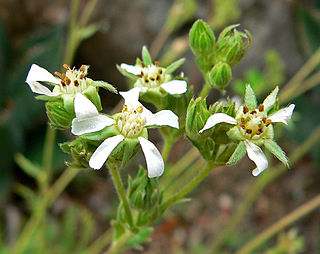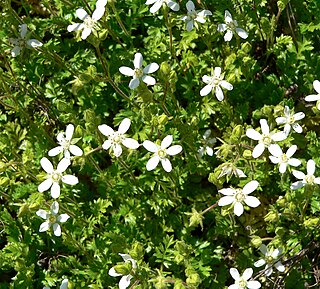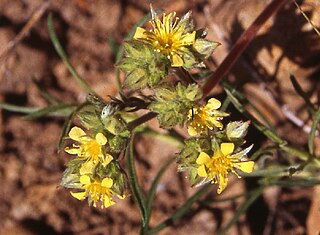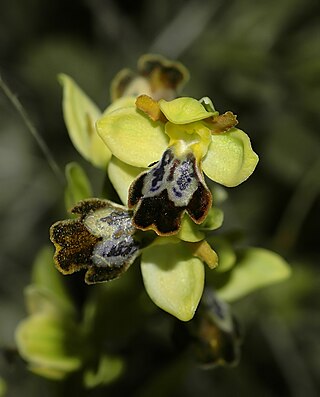
Thelypodium howellii, the Howell's thelypody or Howell's thelypodium, is a rare plant of the Western United States. It is endemic to a relatively small area on the borders of three western States: Oregon, Nevada, and California.
Horkelia bolanderi is a rare species of flowering plant in the family Rosaceae. It is endemic to northern California where it is known from only a few occurrences in two or three counties. It grows in the mountain forests of the North Coast Ranges. This is a mat-forming gray-green perennial herb producing hairy erect stems 10 to 30 centimeters tall. The leaves are 3 to 8 centimeters long and are made up of hairy, toothed leaflets each one half to one centimeter long. The inflorescence holds several flowers, each with five white petals and up to 20 pistils in the center.

Horkelia californica, known by the common name California horkelia, is a species of flowering plant in the rose family.

Horkelia clevelandii is a species of flowering plant in the rose family known by the common name Cleveland's horkelia. It is native to the Peninsular Ranges of southern California and northern Baja California. This is a perennial herb forming clumps of long, fernlike leaves and erect stems. The leaves are up to 18 centimeters long and are made up of triangular to rounded leaflets, each toothed or lobed and covered in thin hairs. The narrow stems reach 10 to 50 centimeters in height and bear inflorescences of several flowers. Each flower has hairy, lance-shaped bractlets and pointed sepals. The narrow oval petals are white. The center of the flower contains ten stamens and up to 50 pistils.

Horkelia cuneata is a species of flowering plant in the rose family known by the common name wedgeleaf horkelia. It is endemic to California, where it grows in coastal chaparral communities and sandy areas. This is a matting or clumping perennial herb producing erect green or red stems up to 70 centimeters tall. The fernlike green leaves are up to 30 centimeters long and are made up of toothed, oval-shaped leaflets each one or two centimeters long. The foliage and stems are often quite hairy. The inflorescence holds several flowers, each with narrow, pointed bractlets and wider, reflexed sepals. The sepals and five white petals may be tinted with bright pink. The center of the flower holds ten stamens and up to 60 small pistils.

Horkelia daucifolia is a species of flowering plant in the rose family known by the common name carrotleaf horkelia. It is native to the Klamath Mountains and surrounding ranges in northern California and southern Oregon. It grows on mountain slopes and fields, often on serpentine soils. It is a perennial herb that produces a rosette of leaves, each five to 15 centimeters long. Each leaf is made up of lobed, hairy leaflets that are one or two centimeters long. The plant produces erect stems up to 30 centimeters tall and bright red or greenish in color. The inflorescence holds several flowers, each with narrow, pointed bractlets and wider, reflexed green or pinkish sepals. The five narrow petals are white, yellow, or pink.

Horkelia marinensis is a rare species of flowering plant in the rose family known by the common name Point Reyes horkelia. It is endemic to the California coastline, where it is known from about Fort Bragg to near Santa Cruz. It grows on beaches and in other sandy coastal areas. This is a perennial herb growing in low, dense patches. The leaves are up to 10 centimeters long and are made up of toothed, hairy, gray-green leaflets each around a centimeter long. The foliage is glandular and strongly scented. The plant produces green to reddish-green stems up to 30 centimeters long which bear inflorescences of dense clustered flowers. Each flower has minute bractlets under reddish-green, fuzzy sepals. The petals are generally white and narrow with rounded ends. The center of the flower contains a ring of stamens around a patch of 20 to 30 pistils.

Horkelia parryi is a species of flowering plant in the rose family known by the common name Parry's horkelia. It is endemic to California, where it grows in the chaparral of the Sierra Nevada foothills. This is a low, mat-forming perennial herb growing in unobtrusive green patches on the ground. The leaves are 5 to 10 centimeters long and are each made up of small, toothed, oval-shaped leaflets. The somewhat hairy green to reddish-green stems are 10 to 30 centimeters long and bear inflorescences of a few flowers each. The flower has minute bractlets under larger, pointed sepals and five white petals. The center of the flower contains a ring of stamens around a patch of up to 50 thready pistils.
Horkelia sericata is a species of flowering plant in the rose family known by the common names silky horkelia and Howell's horkelia. It is native to the Klamath Mountains of northern California and southern Oregon, where it grows in the chaparral and forest, often on serpentine soils. This is a perennial herb growing in small tufts of erect leaves and stems. The leaves are 3 to 15 centimeters long and are each made up of herringbonelike rows of small, tightly packed leaflets. The green leaflets bear long, silky white hairs, giving the plant a silvery green look. The green, brown, or reddish stems reach up to 50 centimeters long and bear loose inflorescences of many flowers. The flower has small green sepals covered in luxuriant white hairs, and white or pink-tinted petals with two-lobed tips.
Horkelia tridentata is a species of flowering plant in the rose family known by the common name threetooth horkelia. It is native to all of the mountain ranges of northern California and southern Oregon, where it grows in coniferous forest. This is a perennial herb forming tufts of erect leaves and stems. The leaves are 3 to 12 centimeters long, each made up of hairy gray-green leaflets which are tipped with usually three teeth. Unlike many other horkelias, this species is generally not strongly scented. The green or reddish stems reach a maximum length of about 40 centimeters and hold clusters of flowers. Each flower has minute bractlets beneath small, hairy, pointed sepals and narrow white petals.

Ivesia aperta is a species of flowering plant in the rose family known by the common name Sierra Valley mousetail.
Crepis bakeri is a species of flowering plant in the family Asteraceae known by the common name Baker's hawksbeard. It is native to the western United States where it grows in many types of mountain and plateau habitat. It is found in Oregon, Washington, Idaho, northern California, Nevada, and Utah.

Ophrys fusca, commonly known as the sombre bee-orchid or the dark bee-orchid, is a species of orchid native to the Mediterranean from southwestern Europe and northern Africa to western Asia. Most subspecies of the Ophrys fusca are pollinated by males Andrena bees.

Horkelia hendersonii is a rare species of flowering plant in the rose family known by the common name Henderson's horkelia. It is known from four populations in southern Oregon, including Mount Ashland, and one population south of the border in Siskiyou County, California. It is a resident of dry forest habitat in the granite soils of the Klamath Mountains. This is a perennial herb producing a low mat of hairy, glandular gray-green foliage about a woody base. The leaves are cylindrical and sometimes tapering to a point, growing erect in a patch around the caudex. Each leaf is 3 to 8 centimeters long and is made up of densely spaced pairs of minutely toothed leaflets. The leaflets are coated in silky hairs. The inflorescence is a dense array flowers atop an erect stalk, each flower made up of five hairy, pointed sepals and five smaller, more delicate white petals.

Horkelia rydbergii is a species of flowering plant in the rose family known by the common name Rydberg's horkelia. It is endemic to the Transverse Ranges of southern California, where it grows in several types of habitat, including pine forest. This is a perennial herb producing a low mat of hairy, glandular gray-green foliage around a woody base. The leaves are mostly flat and made up of pairs of hairy, wedge-shaped leaflets with toothed tips. The inflorescence is an open array of up to 40 flowers atop an erect stalk, each flower made up of five pointed green sepals and five white petals. At the center of the flower is a cone of 10 stamens around a bunch of up to 50 pistils.

Horkelia tenuiloba is a species of flowering plant in the rose family known by the common names Santa Rosa oceanspray, Santa Rosa horkelia and thin-lobed horkelia. It is endemic to California, where it is known only from the coastal hills and mountains north of the San Francisco Bay Area. It is a plant of chaparral habitat. This is a perennial herb producing a low mat of hairy, glandular green foliage around a woody base. The leaves are cylindrical or somewhat flat, often tapering to a point, and each is made up of several densely packed pairs of hairy leaflets. The inflorescence is an array of flowers atop an erect stalk, each flower made up of five pointed green sepals and five white petals. At the center of the flower is a cone of stamens tipped with reddish anthers around many pistils. It flowers in May. It is threatened by trampling, trail maintenance, and development.
Horkelia wilderae is a rare species of flowering plant in the rose family known by the common name Barton Flats horkelia. It is endemic to San Bernardino County, California, where it is known from only about ten occurrences in the vicinity of Barton Flats. It grows in the montane chaparral and woodlands habitat where chaparral meets pine forest, and it is threatened by logging.
Horkelia yadonii is a rare species of flowering plant in the rose family known by the common name Santa Lucia horkelia. It is endemic to California, where it is known from the Central Coast Ranges from Monterey to Santa Barbara Counties. It occupies chaparral and woodland habitat, often in meadows and dry riverbeds. Easily confused with related species, this plant was not recognized as a species of its own until 1993. This is a perennial herb producing hairy, glandular, gray-green mat of erect leaves around a caudex. Each leaf is up to 20 centimeters long and is made up of several pairs of wedge-shaped to rounded leaflets with lobed to deeply notched tips. The inflorescence is an open array of 5 to 10 flowers atop a tall, erect stalk, each flower made up of five pointed, green sepals and five white petals

Silene campanulata is a species of flowering plant in the family Caryophyllaceae known by the common names Red Mountain catchfly and bell catchfly. It may be a synonym of Silene greenei.

Triphysaria eriantha is a species of flowering plant in the family Orobanchaceae, known by the common names johnny-tuck and butter-and-eggs.















